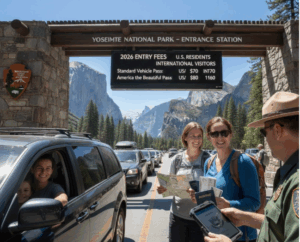Starting in 2026, U.S. national parks will implement a dual pricing system that significantly increases fees for international visitors while maintaining affordable access for American residents. The annual America the Beautiful pass, granting unlimited access to national parks nationwide, will remain $80 for U.S. citizens and permanent residents but will rise to $250 for foreign visitors, marking a 212% increase. Additionally, for the most popular parks—including the Grand Canyon, Yellowstone, Yosemite, Zion, Bryce Canyon, Acadia, Everglades, Glacier, Grand Teton, Rocky Mountain, and Sequoia & Kings Canyon—non-resident visitors without an annual pass will pay an extra $100 per person atop the standard entry fee. This new system is aimed at ensuring sustainable funding for park maintenance, infrastructure upgrades, and enhanced visitor services while keeping entry affordable for Americans who already support the parks through taxes.
To facilitate easier access, all annual passes will be digitized and issued online, allowing visitors to store them on mobile devices without needing physical cards. Previously fee-free “Patriotic Days” such as Presidents Day, Memorial Day, and the Fourth of July will be exclusive to U.S. residents under this policy. While this new pricing framework is designed to relieve the financial burden on American taxpayers, experts warn it may impact international visitor numbers due to the higher costs, particularly affecting families and budget-conscious travelers. This could have wider economic consequences for communities near national parks that depend on global tourism revenue.
The Department of the Interior emphasizes that the additional revenue generated from international visitors will be fully reinvested into the parks, funding trail restoration, facility modernization, improved safety measures, visitor amenities, and upgraded navigation systems. The policy reflects a shift in resource funding that prioritizes domestic affordability while ensuring overseas visitors contribute their fair share toward the upkeep of these treasured natural sites. While the higher fees could influence travel patterns, the reinvestment strategy aims to improve the overall experience and long-term sustainability of U.S. national parks.
Key Points
- Dual pricing system starts in 2026: U.S. residents pay $80 for the annual pass, foreign visitors $250.
- Popular parks charge foreign non-pass holders an additional $100 entry fee.
- Digitized annual passes will be issued online for mobile access.
- Fee-free “Patriotic Days” reserved exclusively for U.S. residents.
- Increased fees aim to fund maintenance, infrastructure, and visitor services.
- Potential decline in international visitors may affect local economies near parks.
- Policy balances affordability for Americans with sustainable funding from international tourists.

















More Stories
Hampton by Hilton Opens First Hotel in Cusco, Peru with $20 Million Investment, Boosting Tourism Growth and Expanding Latin American Footprint
Seville Shines as a Top European Destination for 2026 with Perfect Blend of History and Innovation
Costa Rica Joins Mexico, Brazil, Canada, Dominican Republic, US, and Others in Redefining Green Tourism with Eco-Friendly and Community-Based Solutions